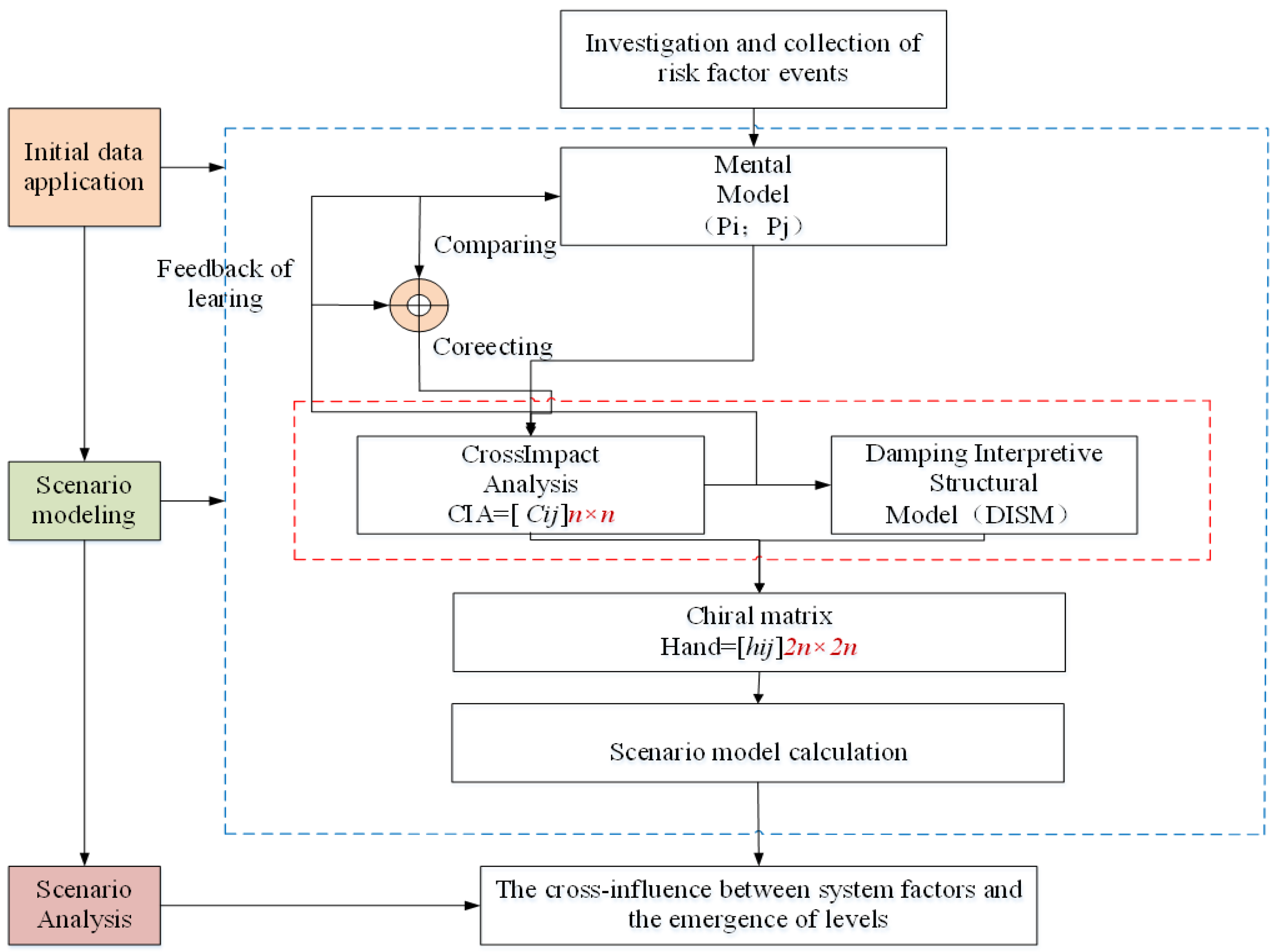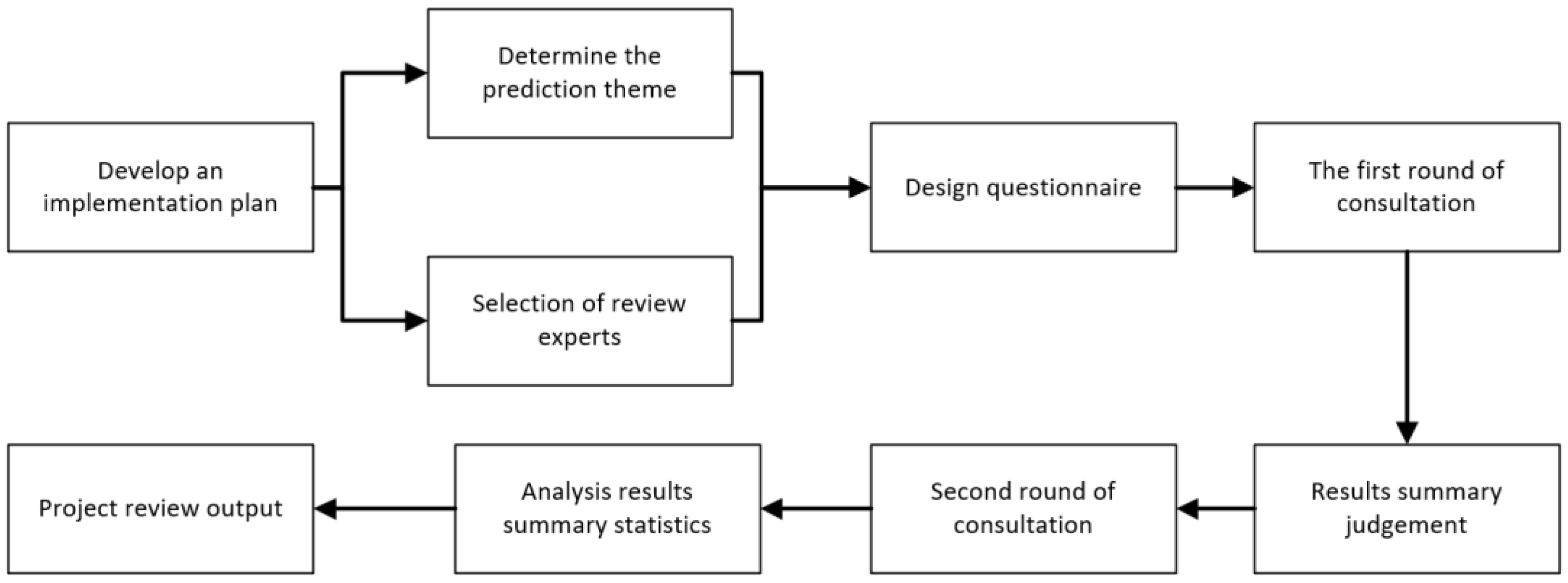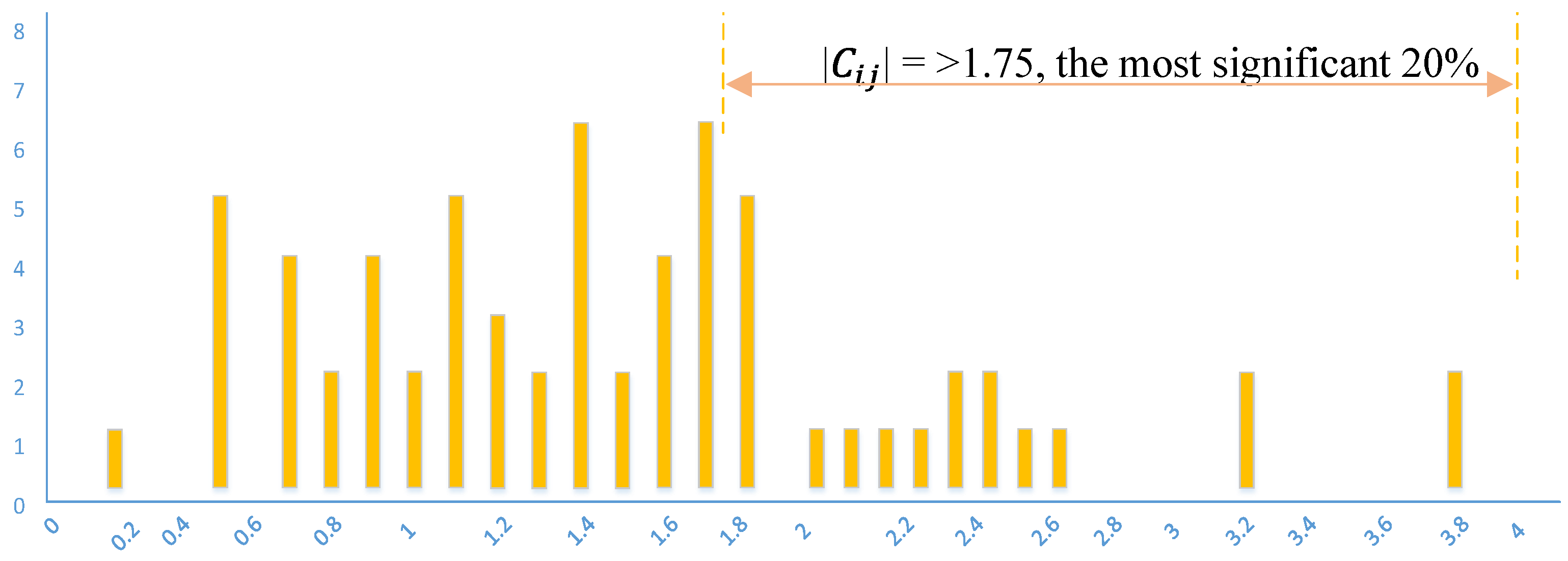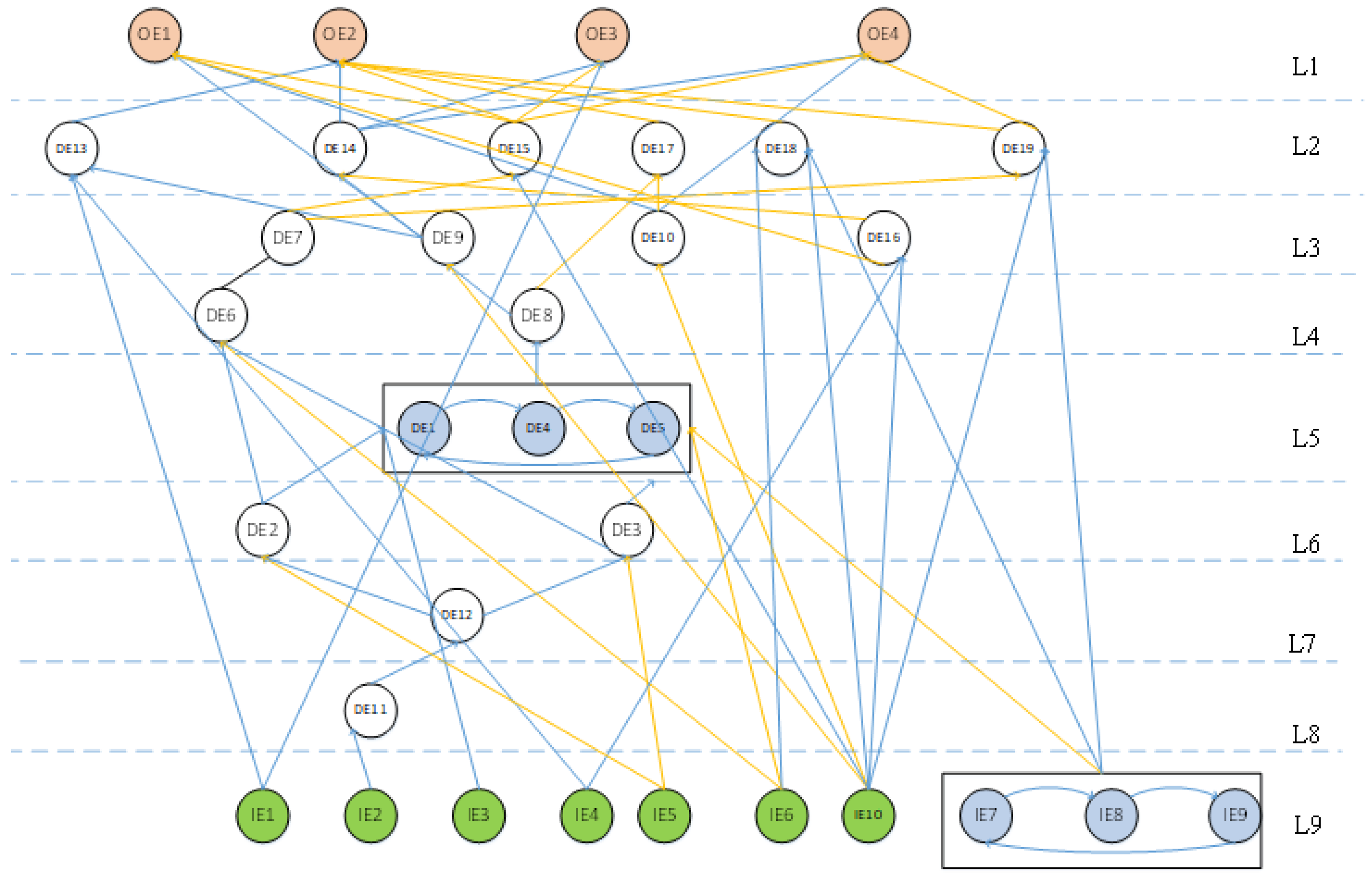Scenario-Driven Methodology for Cascading Disasters Risk Assessment of Earthquake on Chemical Industrial Park
Abstract
1. Introduction
2. Materials and Methods
2.1. Scenario-Based Assessment Model Construction
2.2. The Delphi Method Application Process
- (1)
- The organizers categorized events into initial events, dynamic events and outcome events and asked for expert advice on estimating the relationship between the three categories. Each expert independently made a quantitative estimate of the impact that event i (Ei) (i = 1, 2,…, 33) may have if event j (Ej) (j = 1, 2,…, 33) occurs. The specific quantification rules are shown in Table 1. To thoroughly study the relationship between various events, the team estimated the 10 initial events, 19 dynamic events and 4 outcome events established in Section 3.1 in the way shown in Figure 3. A total of 648 causal relationship estimates could be made, and the results formed a matrix. An initial probability of 0.5 was assumed for the occurrence of each event [1].
- (2)
- The Delphi method is a cyclical process. It should finish with a consensus estimate about the direction and degree of the impact. It is considered to have reached an agreement when no less than two-thirds of the estimated values for a single interaction are in one of these four intervals: between 0.01 and 0.3, between 0.2 and 0.5, between 0.5 and 0.8 or between 0.7 and 0.99.
- (3)
- Once there was an agreement on the direction and degree of the relationship between any two events, the arithmetic mean of the estimates was used as the final estimated value. The estimation matrix can serve as the input for the cross-impact process. The cells in the matrix are the impact estimations Rij (representing the impact that the occurrence of Ej may have on the event of Ei), and the diagonal cells are the overall probabilities (OPV).
2.3. The Cross-Impact Analysis Process
2.4. The DISM Application Process
3. Application
3.1. Event Set Creation
3.2. The CIA-DISM Method Application Process
4. Discussion
5. Conclusions
- (1)
- This paper introduced the DISM model based on the ISM model. By extending the elements of the adjacency matrix from 0 and 1 to −1, 0 and 1, the model results are more accurate. At the same time, by taking the data of the CIA as the input of the DISM model, we can consider the potential causal impact of each event on other events and effectively solve the problem of cross-impact between events.
- (2)
- Based on the CIA-DISM model, the evolution process of cascading disasters in a chemical industry park after the Wenchuan Earthquake was analyzed. A visual network risk assessment model was constructed, which realized the hierarchical and structured relationship between different events, effectively reflected the coupling relationship between events and the transmission path and helped to locate the weak link of cascading disasters. It is possible to cut off the cascading event transmission chain quickly and effectively. The results verify the model’s validity, and the scenario prediction is consistent with the actual situation.
Supplementary Materials
Author Contributions
Funding
Data Availability Statement
Conflicts of Interest
References
- Zhang, Y.; Weng, W.G.; Huang, Z.L. A scenario-based model for earthquake emergency management effectiveness evaluation. Technol. Forecast. Soc. Chang. 2018, 128, 197–207. [Google Scholar] [CrossRef]
- Zhao, J.; Wang, M.; Yang, Z.; Zhang, Y. Construction and evolution analysis of seismic cascading disaster scenario in chemical industry park. J. Nat. Disasters 2021, 30, 102–110. [Google Scholar]
- Tanaka, S. Accident at the Fukushima Dai-ichi Nuclear Power Stations of TEPCO—Outline & lessons learned. Proc. Jpn. Acad. Ser. B-Phys. Biol. Sci. 2012, 88, 471–484. [Google Scholar] [PubMed]
- McArdle, D.; Spencer, C.; Archer, F. Morwell Coal Mine Fire as a Cascading Disaster: A Case Study. Prehosp. Disaster Med. 2019, 34, s8. [Google Scholar] [CrossRef][Green Version]
- Pescaroli, G.; Alexander, D. Critical infrastructure, panarchies and the vulnerability paths of cascading disasters. Nat. Hazards 2016, 82, 175–192. [Google Scholar] [CrossRef]
- Suppasri, A.; Maly, E.; Kitamura, M.; Syamsidik; Pescaroli, G.; Alexander, D.; Imamura, F. Cascading disasters triggered by tsunami hazards: A perspective for critical infrastructure resilience and disaster risk reduction. Int. J. Disaster Risk Reduct. 2021, 66, 102597. [Google Scholar] [CrossRef]
- Thomas, D.S.K.; Jang, S.; Scandlyn, J. The CHASMS conceptual model of cascading disasters and social vulnerability: The COVID-19 case example. Int. J. Disaster Risk Reduct. 2020, 51, 101828. [Google Scholar] [CrossRef] [PubMed]
- Qie, Z.; Rong, L. A scenario modelling method for regional cascading disaster risk to support emergency decision making. Int. J. Disaster Risk Reduct. 2022, 77, 103102. [Google Scholar] [CrossRef]
- Mignan, A.; Wang, Z. Exploring the Space of Possibilities in Cascading Disasters with Catastrophe Dynamics. Int. J. Environ. Res. Public Health 2020, 17, 7317. [Google Scholar] [CrossRef]
- Meng, Y.; Lu, C.; Yan, Y.; Shi, L.; Liu, J. Method to analyze the regional life loss risk by airborne chemicals released after devastating earthquakes: A simulation approach. Process Saf. Environ. Prot. 2015, 94, 366–379. [Google Scholar] [CrossRef]
- Giacomo, A.; Gigliola, S.; Valerio, C. A methodology for the quantitative risk assessment of major accidents triggered by seismic events. J. Hazard. Mater. 2007, 147, 48–59. [Google Scholar]
- Cong, G.; Lu, D.; Liu, M.; Wang, Q.; Yu, W. A New Semi-Quantitative Process Safety Assessment Method and Its Application for Fluorochemical Industry. Processes 2021, 9, 1695. [Google Scholar] [CrossRef]
- Alessio, M.; Valerio, C. A paradigm shift in the assessment of Natech scenarios in chemical and process facilities. Process Saf. Environ. Prot. 2021, 152, 338–351. [Google Scholar]
- Song, Q.; Jiang, P.; Zheng, S.; Kong, Y.; Zhao, Y.; Shen, G. Dynamic Semi-Quantitative Risk Research in Chemical Plants. Processes 2019, 7, 849. [Google Scholar] [CrossRef]
- Xie, X.; Fu, G.; Xue, Y.; Zhao, Z.; Chen, P.; Lu, B.; Jiang, S. Risk prediction and factors risk analysis based on IFOA-GRNN and apriori algorithms: Application of artificial intelligence in accident prevention. Process Saf. Environ. Prot. 2018, 122, 169–184. [Google Scholar] [CrossRef]
- Benson, C.; Argyropoulos, C.D.; Dimopoulos, C.; Mikellidou, C.V.; Boustras, G. Safety and risk analysis in digitalized process operations warning of possible deviating conditions in the process environment. Process Saf. Environ. Prot. 2021, 149, 750–757. [Google Scholar] [CrossRef]
- Long, D.; Faisal, K.; Xiaoxue, G.; Jie, J. A novel approach to reduce fire-induced domino effect risk by leveraging loading/unloading demands in chemical industrial parks. Process Saf. Environ. Prot. 2021, 146, 610–619. [Google Scholar]
- Chen, Q.; Wood, M.; Zhao, J. Case study of the Tianjin accident: Application of barrier and systems analysis to understand challenges to industry loss prevention in emerging economies. Process Saf. Environ. Prot. 2019, 131, 178–188. [Google Scholar] [CrossRef]
- Yang, Z.; Dong, X.; Guo, L. Scenario inference model of urban metro system cascading failure under extreme rainfall conditions. Reliab. Eng. Syst. Saf. 2023, 229, 108888. [Google Scholar] [CrossRef]
- He, X.; Yuan, Y. Revisiting driving factor influences on uncertain cascading disaster evolutions: From perspective of global sensitivity. Phys. A Stat. Mech. Its Appl. 2022, 597, 127217. [Google Scholar] [CrossRef]
- Cerè, G.; Rezgui, Y.; Zhao, W. Urban-scale framework for assessing the resilience of buildings informed by a delphi expert consultation. Int. J. Disaster Risk Reduct. 2019, 36, 101079. [Google Scholar] [CrossRef]
- Varndell, W.; Fry, M.; Lutze, M.; Elliott, D. Use of the Delphi method to generate guidance in emergency nursing practice: A systematic review. Int. Emerg. Nurs. 2020, 56, 100867. [Google Scholar] [CrossRef] [PubMed]
- Bañuls, V.A.; Turoff, M. Scenario construction via Delphi and cross-impact analysis. Technol. Forecast. Soc. Chang. 2011, 78, 1579–1602. [Google Scholar] [CrossRef]
- Warfield, J.N. Toward Interpretation of Complex Structural Models. IEEE Trans. Syst. Man Cybern. 1974, SMC–4, 405–417. [Google Scholar] [CrossRef]
- Kelman, I. Connecting theories of cascading disasters and disaster diplomacy. Int. J. Disaster Risk Reduct. 2018, 30, 172–179. [Google Scholar] [CrossRef]
- Han, L.; Zhang, J.; Zhang, Y.; Lang, Q. Applying a Series and Parallel Model and a Bayesian Networks Model to Produce Disaster Chain Susceptibility Maps in the Changbai Mountain area, China. Water 2019, 11, 2144. [Google Scholar] [CrossRef]






| Number | Explanation |
|---|---|
| 0.9–1 | Significant impact |
| 0.7–0.9 | Obvious impact |
| 0.5–0.7 | Great impact |
| 0.3–0.5 | A certain impact |
| 0.1–0.3 | Slight impact |
| 0 | No impact |
| Event Category | Number | Event Sets |
|---|---|---|
| IE | IE1 | The earthquake occurs during work |
| IE2 | High earthquake intensity | |
| IE3 | The earthquake occurs during peak electricity | |
| IE4 | High population density in the chemical park | |
| IE5 | The seismic resistance of the buildings in the park | |
| IE6 | The seismic resistance of infrastructure, such as road traffic | |
| IE7 | The park has a comprehensive emergency plan | |
| IE8 | Safety awareness and emergency response plans of critical enterprises and factories in the park under extreme conditions | |
| IE9 | The park conducts emergency drills, and the park personnel have a strong awareness of earthquake resistance and safety precautions | |
| IE10 | The quantity and category conformity of emergency supplies for disaster relief | |
| DE | DE1 | The traffic information system was paralyzed, which blocked rescue operations |
| DE2 | Building damage, such as rupture or fall collapse | |
| DE3 | Damaged component or structure | |
| DE4 | Leakage of hazardous chemicals | |
| DE5 | Explosion occurrence | |
| DE6 | Water, electricity and gas supplies disruption | |
| DE7 | Communication network interruption | |
| DE8 | Chemical fire | |
| DE9 | Chemical damage leading to the diffusion of harmful gases and other harmful products | |
| DE10 | Spread of chemical sewage due to leakage | |
| DE11 | Aftershocks continue to occur | |
| DE12 | The earthquake causes a landslide | |
| DE13 | The deterioration of the health of the living environment in the disaster area leads to the outbreak of infectious diseases | |
| DE14 | Social disturbances such as robbery | |
| DE15 | A highly professional rescue team performs rescue missions efficiently | |
| DE16 | Providing humanitarian assistance to those in need | |
| DE17 | Have enough shelter | |
| DE18 | Emergency medical care for victims and basic living facilities | |
| DE19 | The government releases accurate information promptly and can guide public opinion | |
| OE | OE1 | Causing continuous environmental pollution |
| OE2 | Causing heavy casualties | |
| OE3 | Causing significant property damage | |
| OE4 | Improper rescue work and massive casualties, causing social panic |
Disclaimer/Publisher’s Note: The statements, opinions and data contained in all publications are solely those of the individual author(s) and contributor(s) and not of MDPI and/or the editor(s). MDPI and/or the editor(s) disclaim responsibility for any injury to people or property resulting from any ideas, methods, instructions or products referred to in the content. |
© 2022 by the authors. Licensee MDPI, Basel, Switzerland. This article is an open access article distributed under the terms and conditions of the Creative Commons Attribution (CC BY) license (https://creativecommons.org/licenses/by/4.0/).
Share and Cite
Guo, L.; Liang, J.; Chen, T.; Gao, Y.; Yang, Z. Scenario-Driven Methodology for Cascading Disasters Risk Assessment of Earthquake on Chemical Industrial Park. Processes 2023, 11, 32. https://doi.org/10.3390/pr11010032
Guo L, Liang J, Chen T, Gao Y, Yang Z. Scenario-Driven Methodology for Cascading Disasters Risk Assessment of Earthquake on Chemical Industrial Park. Processes. 2023; 11(1):32. https://doi.org/10.3390/pr11010032
Chicago/Turabian StyleGuo, Li, Junming Liang, Tao Chen, Yuan Gao, and Zhen Yang. 2023. "Scenario-Driven Methodology for Cascading Disasters Risk Assessment of Earthquake on Chemical Industrial Park" Processes 11, no. 1: 32. https://doi.org/10.3390/pr11010032
APA StyleGuo, L., Liang, J., Chen, T., Gao, Y., & Yang, Z. (2023). Scenario-Driven Methodology for Cascading Disasters Risk Assessment of Earthquake on Chemical Industrial Park. Processes, 11(1), 32. https://doi.org/10.3390/pr11010032







